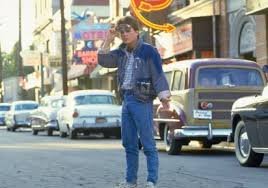Renowned actor and activist Michael J. Fox has described his ongoing struggle with Parkinson’s disease as a “bully,” drawing a striking parallel between his own health journey and the classic film Back to the Future, in which his character faces off against external threats. In a recent interview, Fox said that just as the film’s antagonist Biff is a bully, time is a bully—and for him personally, Parkinson’s disease is the ultimate bully. (Yahoo Lifestyle)
Diagnosed in 1991 at the age of 29, Fox has endured more than three decades of living with the progressive neurological condition. In his reflections, he highlighted the themes of resilience and courage, not only in the film’s storyline but in his real-life journey. He elaborated that while Parkinson’s is part of his identity, his focus remains on the fight—not the defeat. (ABC)
Film Resonance and Personal Metaphor
Fox pointed out that the enduring appeal of Back to the Future lies in its David-versus-Goliath narrative—all the more relevant in today’s “bully culture.” He said: “In this movie, Biff is a bully. Time is a bully. For me personally, Parkinson’s is a bully. And it’s all about how you stand up to them…” (scifinow.co.uk)
That metaphorical framing adds weight to his advocacy work through the Michael J. Fox Foundation, which he founded in 2000 and has since mobilised hundreds of millions of dollars in research funding. His public openness about both the physical and emotional toll of living with Parkinson’s is part of his broader effort to destigmatise the disease and rally global effort toward a cure. (WHO)
H2 Section 1: The Next Chapter in Fox’s Career and Advocacy
While many assumed Fox had stepped away from acting for good, he has quietly re-entered the spotlight—both on-screen and in fundraising. His latest memoir Future Boy recounts his meteoric rise in the 1980s as a 23-year-old balancing a leading TV role and the shoot of Back to the Future, and it also touches on how Parkinson’s shifted his life and purpose. (Yahoo Lifestyle)
In parallel, he continues to front the Michael J. Fox Foundation. According to sources, the Foundation has raised in excess of US$2 billion for Parkinson’s research. (WHO)
From a practical perspective, here are five actionable takeaways for readers—whether you’re a caregiver, someone living with Parkinson’s, or simply supportive of the cause:
- Recognise that Parkinson’s impacts more than movement—non-motor symptoms like mood, cognition and sleep are critical. (ABC)
- Early diagnosis and research participation matter. The Foundation is investing in biomarkers and early-stage trials. (The Blast)
- A holistic approach helps: medication, physical therapy, community support, and adaptive technologies all have roles. (The Independent)
- Advocacy amplifies: Fox’s public voice shows how celebrity platform + scientific support = greater awareness.
- Resilience is a mindset: Fox emphasises that “it sucks” but “it didn’t defeat me.” (The Guardian)
For readers in Adelaide, Australia, this may translate into seeking out local Parkinson’s support groups, registering for clinical trials through the Foundation’s map, or volunteering in fundraising drives associated with the Foundation’s global network.
H2 Section 2: Understanding Parkinson’s Today
Parkinson’s disease affects millions worldwide, and while it is commonly associated with tremors, the full clinical picture is more complex. (ABC)
Here is a structured overview in table-format to help readers grasp key aspects of Parkinson’s, particularly as they relate to Fox’s experience:
H3 — Quick Reference Table
| Aspect | Description | Relevance to Fox’s Journey |
|---|---|---|
| Motor symptoms | Tremor, rigidity, bradykinesia (slowness), postural instability | Fox noted he uses a wheelchair “a lot” and adapts daily. (EntertainmentNow) |
| Non-motor features | Sleep disturbance, cognitive changes, depression/anxiety, autonomic issues | He speaks candidly about the emotional and psychological aspects of long-term disease. (DoYouRemember?) |
| Disease trajectory | Very variable; no fixed timeline; many live decades post-diagnosis | Fox said: “There’s no timeline… it’s much more mysterious and enigmatic.” (ABC) |
| Research status | Advances in biomarkers, therapeutic trials, deep brain stimulation | The Foundation is at the forefront; Fox cited optimism about biomarkers. (The Blast) |
| Quality of life | Multimodal care—meds, therapy, lifestyle modifications, social support | Fox emphasises adapting: “I wake up and get the message of what the day is going to be like.” (EntertainmentNow) |
H4: Implications for Broader Audiences
Fox’s framing of Parkinson’s as a bully invites a broader reflection not just on his personal condition but on cultural and systemic dynamics—such as how society treats chronic illness, how individuals muster resilience, and how public figures can catalyse research and policy.
For professionals in healthcare or advocacy, there are a few key take-aways:
- Leveraging metaphors (like the bully motif) can improve public understanding and health communication strategies.
- Partnerships between research foundations and entertainment figures can drive funding and awareness in powerful ways.
- Monitoring the long-term stories of individuals (such as Fox’s three-plus decades) can inform expectations and care planning for early-onset cases.
For patients, caregivers or community members, Fox’s example underscores that a diagnosis does not have to define one’s identity or limit one’s purpose. Instead, sustained action—whether in advocacy, research funding, or personal care—can shift the narrative from victimhood to agency.
In sum, Michael J. Fox’s dual legacy as both Hollywood star and Parkinson’s advocate continues to evolve. His words remind us that while the disease may act like a bully, the fight is ongoing—and the final act is far from written.
